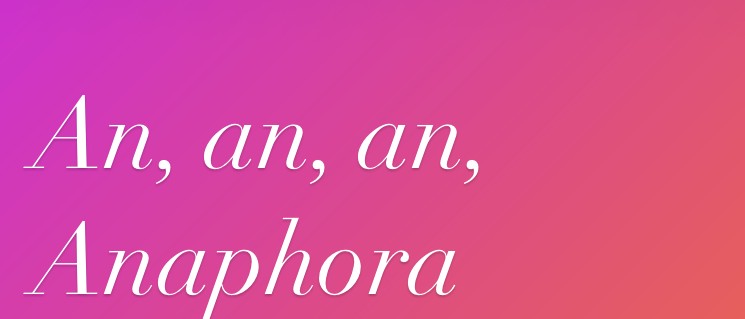My students surprise me every day. My students delight me every day. My students amuse me every day. My students question me every day.
The repetition of phrases like that is a rhetorical device known as an anaphora. While we encounter anaphoras often, we likely do not hear 16 years talking about anaphoras with high frequency.
I had to chuckle after my third student began discussing an “eloquent anaphora” that they encountered during a rhetorical analysis writing prompt. This was odd since, I, their language teacher, had not taught them the term anaphora. And then… I wondered if my students had somehow conferenced about this phenomenon, because, after 5 “eloquent anaphoras” and 4 common place anaphoras, the trend was overt.
In discussing (read: tweeting about) this with an English teacher that many of my students had last year, I learned that this particular device was something that was discussed a year ago. It was in an example essay Mrs. Clark had provided.
That same week, I noticed another overt behavior. My students in my second hour class all opened and shared a spreadsheet. They needed to sign up for tasks by writing their name. In my second hour, one student changed her font color to green. Then I saw a student change his font to blue. Before I knew it, most of the students had changed their font colors — there was no instruction around this, they all just did it. In my third hour, a student changed her font size from 12 to 18; she changed her font to a flowery script. Sure enough, font sizes and type faces began transforming on the sheet.
Through these two events, and an endless supply of similar anecdotes over the years, one thing I know to be true is that our students are very impressionable. While I think most teachers understand the power of providing and performing examples, I wonder if we realize the power we hold each and every day.
Students simultaneously crave two things: permission to explore, and benchmarks for success. If a teacher tells them “this is a good thing to mention,” they lock it away; if they witness other students having fun, and the teacher allows it, they dive into the fun.
So, I wonder, if we realize how often they look to us for these permissions and benchmarks. Do their teacher’s participate in Spirit Day, or are they too cool? Do the teachers gossip about other people, or politely change the subject? I wonder how many students see the countless decisions I make in a day and take away either permission to behave similarly, or take note of a benchmark of a responsible adult.
We know they are watching us, but do we always consider what they’re seeing? Are we mindful of the little choices we make, and who sees us doing what?
I would hope that over the years, my demeanor grants permission for exploration and curiosity; I would hope my behavior serves as a model of how I want these young adults to mature.
I knew my students will go on to use vocabulary I taught them and repeat other content skills. But now, I wonder, what other behaviors they pick up or observe in me… Because they certainly are observing.
They surprise. They delight. They amuse, and they question. They’re little personified anaphoras — repeating what they see and experience, and it’s our job to be good models for them to follow.









